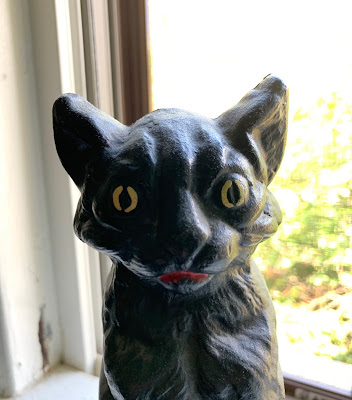In my last post, I wrote about Nathan Selee, an alleged wizard who lived in Easton, Massachusetts in the 18th century. People in New England believed that witchcraft ran in families, so it's not surprising one of his sisters was also considered a witch. Her name was Thankful Selee Buck.
Once again, I get my information about the Selee family from William L. Chaffin’s History of the Town of Easton (1886). The stories about Thankful are not as outrageous as those told about her brother. There are no demonic imps running sawmills, or mysterious strangers presenting books of evil magic. Instead, we mostly have classic New England tales of witchcraft.
For example, Chaffin writes that "Loads of hay were sometimes stopped in front of her house, and could not move until she gave the signal, when a black cat was seen to come out from under the hay and glide away." This type of legend is associated with many other witches across New England, although not always with a black cat involved. And just what (or who?) was that mysterious feline?
A neighbor was said to have caught a black cat doing some mischief, and to have given her a severe beating on the head; the next day it was observed that Thankful Buck had lost an eye. (Chaffin, History of Easton)
Stories about mysterious animals and injured witches have been told in New England for hundreds of years, starting with the Puritans. It was widely believed that witches could project their souls out of their bodies in the shape of animals. These animals were still subject to physical harm, though, so if someone hurt the animal the injury would appear on the witch's human body. Ouch! In some stories, the animals are even killed, which causes the witch to die.
 |
| Photo courtesy Library of Congress |
Chaffin does tell two stories about Thankful Buck that are more unusual. They both relate to her family. First, he writes that she was "said to have performed her incantations at midnight with her daughters, one of whom inherited her name and reputation, by pouring water from one pan into another." As I mentioned, New Englanders believed witchcraft ran in families, so it makes sense people in Easton thought at least one of Thankful's daughters was a witch. The detail about using two pans of water is an interesting one, and I don't think I've seen that one before. If anyone tries this at midnight, let me know the result!
Finally, Chaffin writes that Thankful once sent her husband to buy her a particular type of wool fabric. He returned home empty-handed, and was unable to enter the house due to an angry Thankful's magic. Only when he came home with the fabric was he able to get into the house. This story makes me laugh - do not make a witch angry! - but it also points out how often these stories about the fear of powerful women. Clearly, she was the one in charge of the Buck household.
William Chaffin claims that even when he was writing in 1886, some of his Easton neighbors still believed these stories were true. Chaffin is skeptical; he wonders, for example, why Thankful Buck didn't use her magic to save her eye, or if perhaps Thankful and her brother Nathan deliberately cultivated reputations as witches to instill fear in their neighbors.
I suppose that's possible - see for example the Dogtown witches - but I think it's more likely the Selees and Bucks were just unpopular with their neighbors. Perhaps they were demanding, or maybe they were rude and ill-mannered. It didn't take much to get accused of witchcraft in these small New England town. Happily, they lived after the witchcraft trials ended, so they were not brought to court or executed. I appreciate these old witchcraft legends, but I always try to remember they were about real people, not magical witches.












